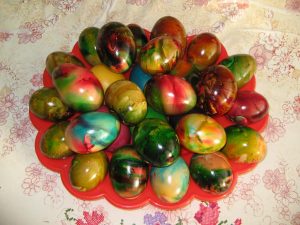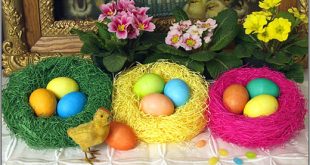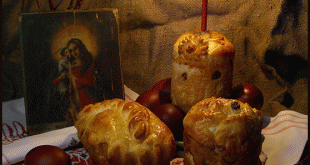Traditionally, Easter eggs are being dyed morning of Monday, Thursday or Holy Saturday. The first egg should be painted red. It is the used to paint a cross on the foreheads of children and then other family members.
The first painted egg is kept until next Easter. It is believed that it brings health, luck and happiness. The second egg must also be painted red. It must be left in the church after Liturgy in the night before Easter. All the other eggs can be painted on your own with any color.
In order to be more durable and hard-boiled, egg is cooked in salted water about 10-12 minutes, as the minutes are counted from the moment, when the water starts boiling. Once boiled, they should be left t cool down in the water, then taken out and dried before painting. If they will be made with tartaric acid, it is added at the end of the boiling. Then the eggs are covered with beautiful shiny crystals.

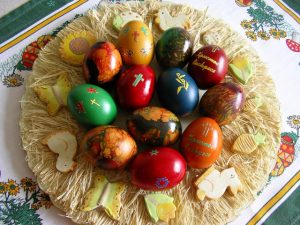 Classic Painting
Classic Painting
It is known to every housewife. Boiled eggs are immersed in the pre-diluted paint and kept at least 8-10 minutes in it. The more you hold the egg, the more saturated the color becomes. If you want a lighter color, keep them less. After receiving the desired color, the eggs are taken out and placed to dry on absorbent paper and then polished with cotton soaked with oil. Maybe on some of them you can add stickers or decals in the prescribed manner. Currently on the market there are various stickers that make eggs very beautiful.
 Painting eggs with added oil
Painting eggs with added oil
In the paint dissolved in the prescribed manner, add 1-2 tablespoons oil. When the egg is dipped, part of the oil sticks to it and does not allow these places to be painted. So eggs are mottled. They are consistently immersed in several colors and then the effect is really very good and colorful. Then the eggs are dried and polished with oil.
Painting eggs with gelatin
Boiled and cooled, the egg is dipped in a solution of water bath gelatin. Once removed from gelatin, egg is painted by hand, using a cotton swab and various paints dissolved in thick porridge. The paints must be pulverized in order to be prepared in this way with very little water. Paint is spilled in gelatin to get many bright and beautiful eggs. If you have a good imagination and skillful hands, the good result is guaranteed. You will need a little more patience and desire, but you will be satisfied. Note that the eggs dry out slowly.
 Painting eggs with cotton
Painting eggs with cotton
Put dissolved paint in different colors on a piece of cotton so big that it can be wrapped around the whole egg. The egg must be wrapped tightly in cotton and left for 5-10 minutes. The more it stay, the more bright and dark colors become. Once ready, the egg is removed from the cotton, it must be dried and polished. One piece of cotton should not be used more than 2-3 times, because the result becomes unsatisfactory. Working with gloves is a must if you do not want your hands to acquire the color of the eggs.
Painting eggs using a sock
 Option I: This method is very old and is from our grandmothers. Eggs are very beautiful. They used raw eggs, because during the painting the eggs get cooked. Prepare in advance as follows: Each egg is tied tightly in a piece of thin women’s pantyhose, but before that it is wrapped in the skin of the red onion. Only the top and darker union husks are used. There is no need for the husk to cover the entire egg. It must be well stretched in pantyhose and tied tightly. The prepared eggs are then boiled for 10-12 min. Taken out of the water and without removing tights, allowed to cool down for awhile. Then dipped in paint, colored as desired and after 5-7 min., they are removed and allowed to drain well. Then carefully pantyhose should be carefully removed and onion flakes and after the eggs cool completely, they should be polished.
Option I: This method is very old and is from our grandmothers. Eggs are very beautiful. They used raw eggs, because during the painting the eggs get cooked. Prepare in advance as follows: Each egg is tied tightly in a piece of thin women’s pantyhose, but before that it is wrapped in the skin of the red onion. Only the top and darker union husks are used. There is no need for the husk to cover the entire egg. It must be well stretched in pantyhose and tied tightly. The prepared eggs are then boiled for 10-12 min. Taken out of the water and without removing tights, allowed to cool down for awhile. Then dipped in paint, colored as desired and after 5-7 min., they are removed and allowed to drain well. Then carefully pantyhose should be carefully removed and onion flakes and after the eggs cool completely, they should be polished.


Option II: On pre-boiled egg place a leaf of grass with an interesting shape or a carved figurine of an impermeable material. Egg clamped in pantyhose and put in the paint. After staying subtracted, allow to drain and carefully remove the pantyhose. The place of the figurine or petals remains unpainted. Once dry polish.
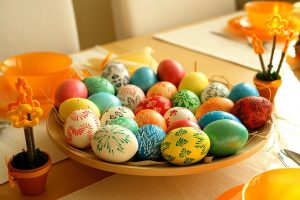 Painting eggs using wax
Painting eggs using wax
The eggs are boiled and allowed to cool down. When cooled completely paint eggs with wax figures or inscriptions. Then paint the normal way, but when painted with wax, the paint does not stay and egg remains white. Thus the figures appear to have been painted, but actually the rest of the egg is.
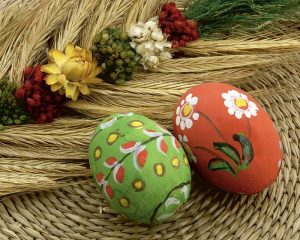 Painting eggs using watercolors and pencils
Painting eggs using watercolors and pencils
Boiled eggs are painted with paint for eggs in the conventional way. Then after they have dried completely, put a proper cup-stand and paint by hand with harmless paints or pencils. There are many options, depending on your imagination and skill.
 Happy at Home Family Problems & Solutions | Home & Health Tips
Happy at Home Family Problems & Solutions | Home & Health Tips

